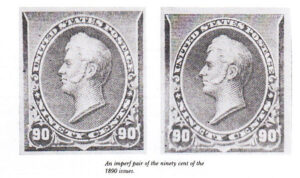 After 1890, United States stamps changed. For the first forty-three years of stamps, printing methods were not nearly as mechanized, resulting in numerous printing varieties. Furthermore, the wide variety of cancellations on the stamps and the panorama of different usages in the earlier period encourage collectors to specialize in a particular issue or even a particular stamp. From the 1890 philatelic period onward, this highly specialized collecting of a single issue or even a single stamp has been done far less commonly. There are comparatively few varieties in post-1890 stamps. Color was matched with precision, resulting in few of the color variations between printings so common in the earlier period. The economics of automatic canceling equipment forced a sameness into American cancellations of the modern period that has tended to discourage cancellation collectors. And the rising popularity of philately after 1890 has meant that quantities of philatelic material were saved, resulting in fewer real rarities. In addition, the goal of discovering the usage and varieties of each stamp, which is one of the joys of philately, was no longer necessary. Contemporary philatelists in the post-1890 period were there to chronicle each variety first hand. When you add to all of this the United States Post Office Department’s catering to collectors in an attempt to improve its own balance sheet, the picture of the modern philatelic era is complete.
After 1890, United States stamps changed. For the first forty-three years of stamps, printing methods were not nearly as mechanized, resulting in numerous printing varieties. Furthermore, the wide variety of cancellations on the stamps and the panorama of different usages in the earlier period encourage collectors to specialize in a particular issue or even a particular stamp. From the 1890 philatelic period onward, this highly specialized collecting of a single issue or even a single stamp has been done far less commonly. There are comparatively few varieties in post-1890 stamps. Color was matched with precision, resulting in few of the color variations between printings so common in the earlier period. The economics of automatic canceling equipment forced a sameness into American cancellations of the modern period that has tended to discourage cancellation collectors. And the rising popularity of philately after 1890 has meant that quantities of philatelic material were saved, resulting in fewer real rarities. In addition, the goal of discovering the usage and varieties of each stamp, which is one of the joys of philately, was no longer necessary. Contemporary philatelists in the post-1890 period were there to chronicle each variety first hand. When you add to all of this the United States Post Office Department’s catering to collectors in an attempt to improve its own balance sheet, the picture of the modern philatelic era is complete.
But don’t for a minute think that post-1890 philately is boring; it is not, it is just more predictable. And because early philatelists saved quantities of post-1890 issues, don’t think that the prices will be low. The period from 1890 to 1930 is the most popular philatelic period among intermediate and expert collectors, so while more material is available, more collectors are competing for it as well.
The 1890 issues (#219-229) are attractively printed. Although not uncommon in used condition, Very Fine mint copies are very scarce. Each of the values is known imperforate. The imperforates were deliberately ordered by the Post Office Department when it turned over its entire collection to the National Postal Museum (which still operates today under the name Postal History Division of the History and Technology Museum of the Smithsonian). When the collection was turned over, a number of gaps were discovered in the collection, especially in stamps such as inverts that were inadvertently produced and were never ordered by the department. The museum used the imperforate 1890 issue to trade with dealers and collectors for stamps that the collection needed. Congress did not appropriate money to expand the collection, no doubt feeling that philatelists were no great lobby to contend with. But because of the museum’s trades, such items as the fifteen-cent, twenty-four-cent, and thirty-cent 1869 inverts can be seen today by people who otherwise would never have the opportunity. Considering the rarity, the imperforate pairs do not sell for a great deal, probably attesting to some distaste over the face that these imperforates were manufactured deliberately by the government to trade at a premium over their face.



